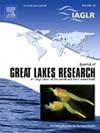Comparisons of isotopic niche between females and male alternative reproductive tactics of Chinook salmon (Oncorhynchus tshawytscha) from Lake Ontario
IF 2.4
3区 环境科学与生态学
Q3 ENVIRONMENTAL SCIENCES
引用次数: 0
Abstract
Chinook salmon (Oncorhynchus tshawytscha) have complex life histories with two distinct male alternative reproductive tactics (ARTs). The larger and older “hooknose” males battle for position to spawn with nesting females whereas the precociously maturing “jack” males use a sneaking tactic to gain access to females. Although dietary niche is known to differ between ARTs of other fish taxa, no research to date has examined these differences in a salmonid. Here, we used δ15N and δ13C stable isotope analyses to compare the dietary niches of female, hooknose male, and jack male Chinook salmon sampled from a Lake Ontario tributary. We found that all three life histories shared similar δ15N values, whereas jack males had greater δ13C values compared to hooknose males, with females having intermediate values. Jack males also had notably little overlap in their isotopic niche space with hooknose males and females, indicating that jack males occupy a distinct isotopic niche in Lake Ontario. We discuss habitat partitioning and differences in dietary niche as explanatory factors. Altogether, these data unveil novel distinctions in isotopic niche within the complex life history strategies of Chinook salmon in Lake Ontario that can inform management decisions and provide avenues for future research.
安大略湖奇努克鲑鱼雌、雄两种生殖策略的同位素生态位比较
奇努克鲑鱼(Oncorhynchus tshawytscha)具有复杂的生活史,具有两种不同的雄性选择性生殖策略(ARTs)。体型更大、年龄更大的“hooknose”雄性为了与筑巢的雌性交配而争夺位置,而早熟的“jack”雄性则使用偷偷摸摸的策略来接近雌性。虽然已知其他鱼类分类群的饮食生态位存在差异,但迄今为止还没有研究检查过鲑科鱼类的这些差异。本文采用δ15N和δ13C稳定同位素分析方法,比较了来自安大略湖支流的雌性、hooknose雄性和jack雄性奇努克鲑鱼的饮食生态位。我们发现这三个生活史的δ15N值都很相似,而杰克雄鹿的δ13C值高于虎鼻雄鹿,而雌鹿的δ13C值介于两者之间。在同位素生态位空间上,雄杰克与雌和雄杰克的重叠也很少,表明雄杰克在安大略湖占据着一个独特的同位素生态位。我们讨论了生境划分和饮食生态位的差异作为解释因素。总之,这些数据揭示了安大略湖奇努克鲑鱼复杂生活史策略中同位素生态位的新区别,可以为管理决策提供信息,并为未来的研究提供途径。
本文章由计算机程序翻译,如有差异,请以英文原文为准。
求助全文
约1分钟内获得全文
求助全文
来源期刊

Journal of Great Lakes Research
生物-海洋与淡水生物学
CiteScore
5.10
自引率
13.60%
发文量
178
审稿时长
6 months
期刊介绍:
Published six times per year, the Journal of Great Lakes Research is multidisciplinary in its coverage, publishing manuscripts on a wide range of theoretical and applied topics in the natural science fields of biology, chemistry, physics, geology, as well as social sciences of the large lakes of the world and their watersheds. Large lakes generally are considered as those lakes which have a mean surface area of >500 km2 (see Herdendorf, C.E. 1982. Large lakes of the world. J. Great Lakes Res. 8:379-412, for examples), although smaller lakes may be considered, especially if they are very deep. We also welcome contributions on saline lakes and research on estuarine waters where the results have application to large lakes.
 求助内容:
求助内容: 应助结果提醒方式:
应助结果提醒方式:


